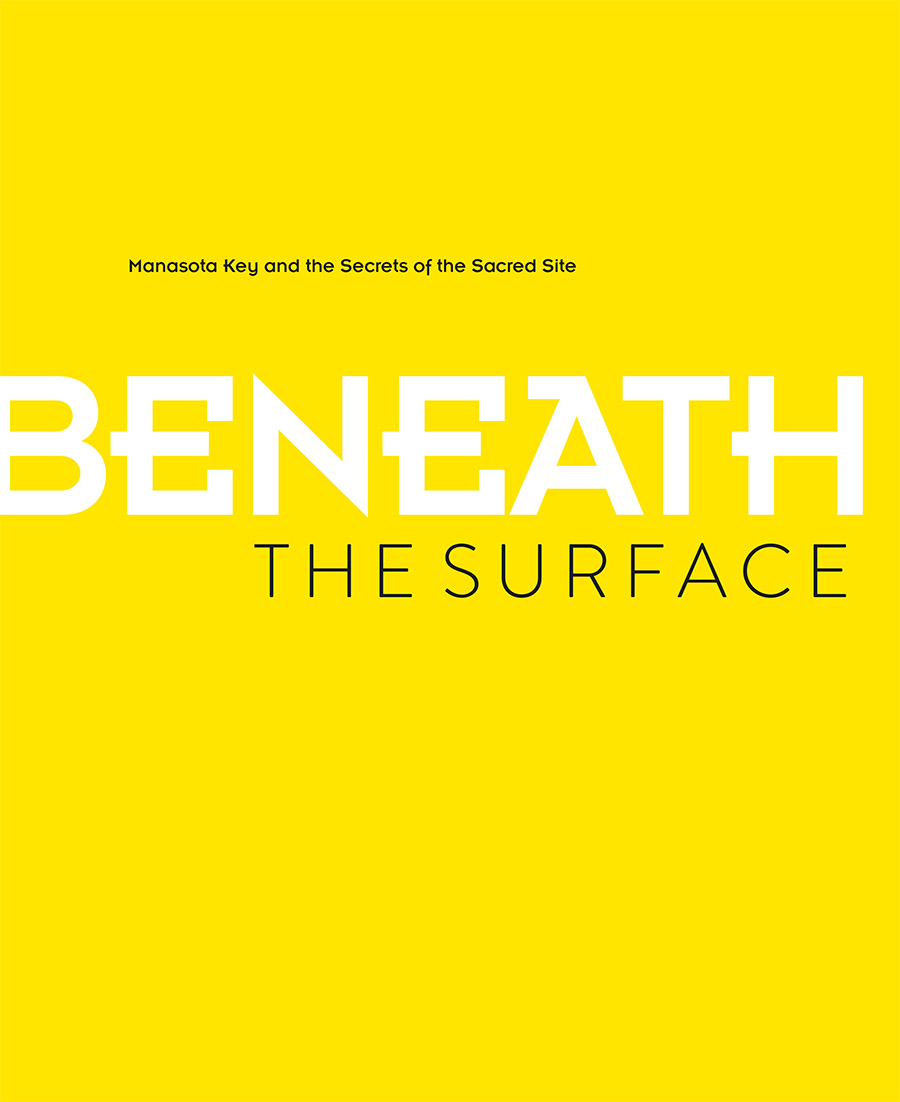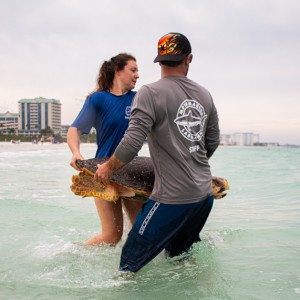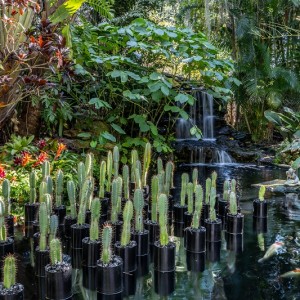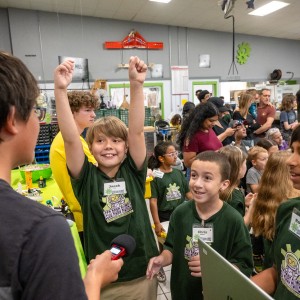For about nine years, Joshua Frank was diving near Venice. At least once a week, usually on weekends, he’d strap on the scuba gear and take the plunge into the cool blue water and let the world disappear behind him, alone with his thoughts on the ocean floor. “Your cell phone doesn’t ring, nobody can talk to you,” he says. “It’s pretty relaxing.”
And exciting. Venice enjoys its reputation as the shark tooth capital of the world for a reason, and Frank enjoys it too. Combing the sea floor, going anywhere from 15 to 40 feet deep, he’ll find fossilized teeth the size of his palm. Some days he’ll even find fossilized bones from the great Ice Age beasts that used to roam the Florida wilderness when it looked like something altogether different.
Can it be spooky down there too? In the relative dark, with low visibility and the pointed reminders of marine predators all around? Sure, says Frank. “Greed helps you get over the nerves,” he says. “If you’re greedy enough for the big shark teeth and good fossils, you get over your nerves.”
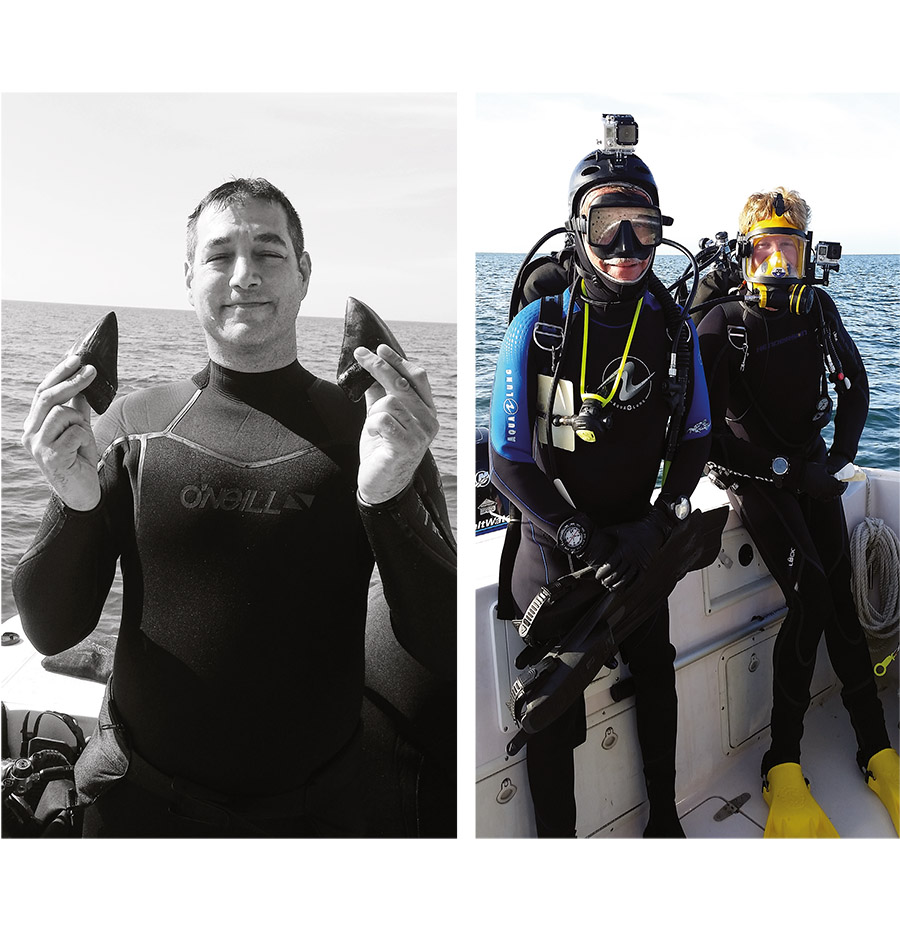
Above; left to right: Joshua Frank with some Megalodon teeth, courtesy of Joshua Frank. Steven Koski and Neil Puckett, courtesy of Steven Koski.
On this particular Saturday in June 2016, Frank hadn’t found much at all. So when he came across something “peculiar”—half of a lower jawbone, with one worn tooth still in its socket—he picked it up. It was dark brown and lighter than most fossils, and didn’t appear to belong to any marine animal Frank was familiar with. He tucked it in his bag and moved on. There were monkeys in part of Florida, he remembered absently. “Perhaps some weirdo had a monkey on a sailboat and it fell over and died,” he thought.
That night, the bone stayed in the bag. On Sunday, Frank took it out and laid it on a paper plate atop his kitchen table. In the plain light of day, a different conclusion emerged: if this had anything to do with the weirdo and the monkey, it probably had more to do with the weirdo. He contacted a paleontologist friend working in the University of Alabama museum system, who forwarded the images to the manager of the Human Osteology collection. The bone, he said, was most likely human.
By the end of the day, Frank was on the phone with Dr. Ryan Duggins, Underwater Archaeology Supervisor for the State of Florida’s Bureau of Archaeological Research. Hearing Frank’s story, Duggins arranged for a forensic anthropologist to examine the find. Enter Dr. Heather Walsh-Haney, a Florida Gulf Coast University associate professor who has, for 14 years, assisted the state pro bono in cases across Florida, evaluating human remains to determine cause of death and, importantly, time of death. Out of 80–100 cases a year, maybe 5–10% result in a call to the archaeologist. Walsh-Haney knew the remains were human, and, in this case, dentition made clear that they were not modern either, with a tooth worn down by an early diet full of grit, and exposed dentin in great dark splotches. “When I can see those patches,” says Walsh-Haney, “I understand that it is inconsistent with what we normally see in modern contexts, where folks have access to personal care and hygiene.”
Still, the first hunch and most likely theory remained that the bone came from some terrestrial site, washed into the ocean to be found far from its origin. But the bone showed no sign of such underwater tumbling either, and a startling picture emerged, alongside the possibility of an unprecedented find. Duggins had to find Frank, and Frank had to find that spot again.
“That is the needle in the haystack of any archaeology,” says Duggins, “and then you complicate that with working underwater.” But Frank’s memory proved keen, and after an afternoon on the boat, he, Duggins and the crew were exploring the seabed looking for evidence that Frank’s find was not a fluke, but perhaps evidence of something more. Frank brought his wife. She found a human skull with a wooden stake through it. After that, Frank would make a couple dives, with permission, to see the underwater archaeological site in action. Duggins’ and Walsh-Haney’s involvement was just beginning.
A PARADIGM SHIFT
Two years on, scientists are looking more than 7,000 years into the past at what has been dubbed the Manasota Key Offshore site (MKO). What began with a chance discovery from an amateur diver has blossomed into one of the most remarkable modern archaeological finds and a game-changer for conventional wisdom in offshore archaeology—a burial site with human remains and artifacts dating up to 7,200 years old, somehow still preserved and intact, though swallowed by the sea long ago. “It’s unprecedented,” says Duggins, “and it’s going to change the way a lot of people think about archaeology on the continental shelf.”
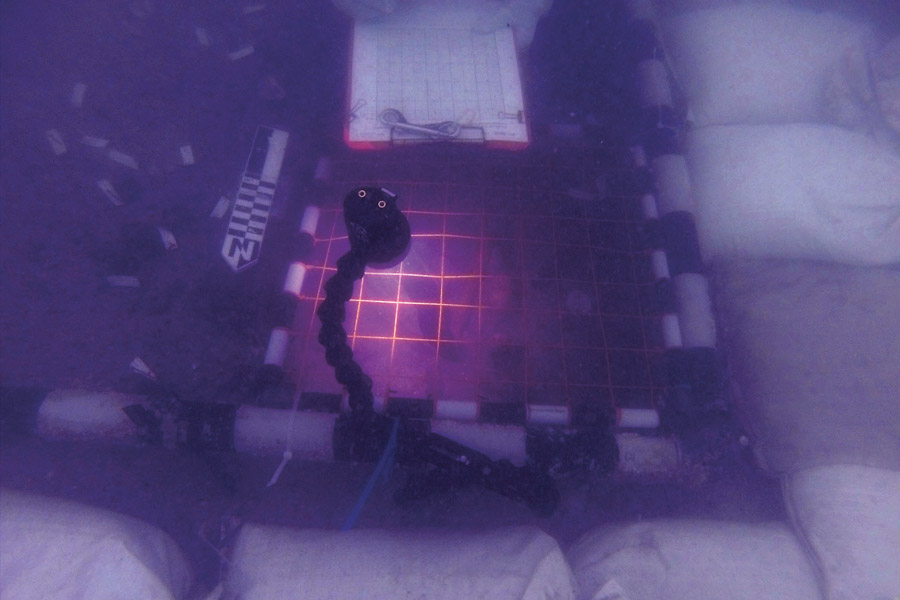
This page:Grid mapping. An archaeologist uses a grid to map a section of the test unit. Photo credit: Ivor Mollemu, Florida Department of State.
22,000 years ago, much of the Gulf of Mexico stood above water, thanks to lower sea levels. Somewhere in the past 14,000 years, all that land began to flood as the ice caps melted, and scientists know that through at least part of this gradual flooding, humans made this previously exposed land their home. All of these thousands of years of human activity out on what is now known as the continental shelf was long thought to be destroyed by the elements and lost to time. The MKO site throws that assumption into question.
“We’re always told in school that archaeology of the continental shelf is going to be destroyed,” says Duggins. “It’s going to be limited to arrowheads, and you’re not going to see preservation of organic material.” But what Frank, Duggins and others have uncovered stands in stark contradiction, and paints a clear picture of what used to be there—a freshwater pond, above ground, and the site of ritual burial, as evidenced by both human remains and a combination of textile and fire-sharpened wooden stakes, which would be used to wrap the body and anchor it to the bottom of the pond. “This is an archaeological signature that we’ve seen in sites across the state,” says Duggins.
“This is what everybody’s been looking for,” says Steve Koski, a Sarasota County underwater archaeologist who has been working in Florida since 1985, when he began by examining shell middens off Venice Beach with his professor. Turning inland, Koski then worked as an underwater archaeologist from ’86 to ’90 at the sinkholes of Warm Mineral Springs, thought to hold the oldest known intentional burial in North America, before moving on to another North Port paleontological site, Little Salt Springs, where he worked until 2013. So when Duggins got to Manasota Key, he called Koski and asked him to participate. Koski agreed immediately. “There are no other sites like this one,” he says, “and there are few sites of this integrity. It provides an opportunity to examine the attributes that facilitate preservation and examine a site that is up to 7,000 years old—that is the dream come true.”
What was once a needle in a haystack is now a flurry of activity. Initial dives identified the site as formerly a freshwater feature—a small pond or lake previously above ground—evidenced by a shift from the usual marine sediment of sand, shell and coral to an organic peat with leaves, twigs, branches and even snail shells. The last two years have then been spent addressing three key questions: how broad is the site, how deep is the site and how dense is the site?
But any answers would be hard coming, buried deep in the peat and underwater, forcing researchers literally out of their element and into cumbersome equipment for delicate work, where a minor misstep could spell disaster, for both the site and the scientists. As Duggins puts it: “We’re on life support when we go to work.” But the energy, adds Koski, is like nothing else.
CLUES IN THE BLUE
The day begins early, with typically two to three boats laden with heavy equipment and expectant scientists converging above the site. Lashed together for stability but still rocking in the waves, the vessels form something of a marine base of operations, from which divers descend and to which artifacts and sediment collect, either brought up in bags with the divers or sucked up by a giant dredge pumping noisily on the deck.
Underwater, the chaos is muted but visibility is poor, often no more than two or three meters in any direction. Still, all team members wear GoPro cameras attached to their helmets, creating a video record of the exploration as it unfolds. Divers descend in teams of two or three, with individuals staying as long as the air in the tanks holds out, which, depending on breathing rate, could be 40 minutes or an hour. On the way up, the next diver is already on the way down. In addition to the GoPros, some are equipped with radios, keeping lines of communication open with the surface. “It’s a coordinated system that lasts all day,” says Koski.
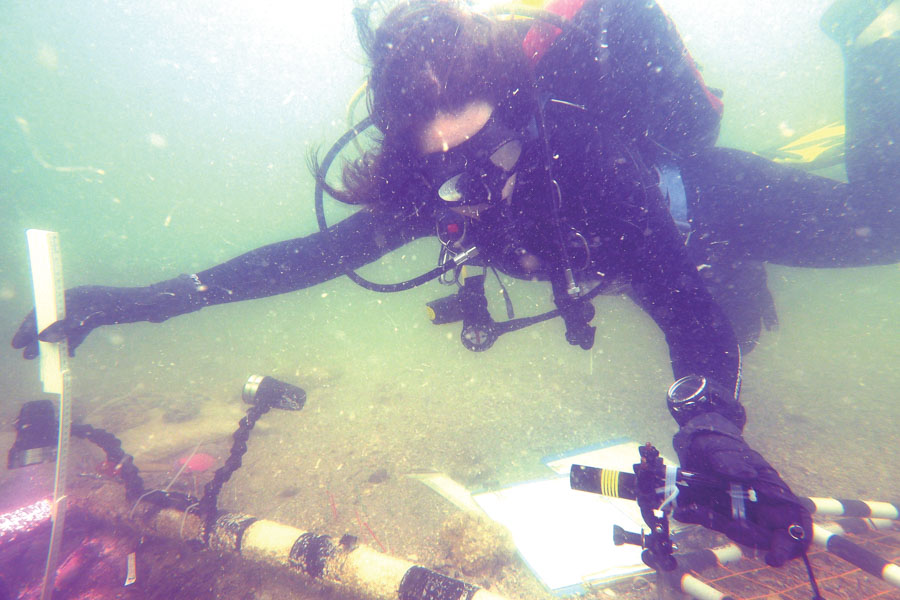
This page:FPAN partner Nicole Grinnan measures the test unit’s depth using a laser level and folding ruler. Credit: Ivor Mollema, Florida Department of State.
Of the three key questions, early dives combined sensing equipment and visual inspection to determine the breadth of the MKO site, with Duggins’ conservative estimate now placing the pond at about three quarters of an acre in size “at a minimum.” “We know it used to be bigger than that,” he says. “We also know that the visible extent of the pond is not nearly indicative of its true size.” To determine depth, the teams inserted a number of sediment cores into the site—12-foot-long hollow metal tubes three inches in diameter that, when plunged into the seafloor and removed, yield a sort of earthen plug with a stratified view of the ocean floor below. This revealed scattered depths of at least half a meter, but until the site is mapped in its entirety, greater depths remain possible. In the end, of the original three questions, the density of the site proved the greatest surprise. “We were not prepared for this at all,” says Duggins. “It was incredible.”
Creating what researchers refer to as a “test unit”—a one-by-one meter excavation square where underwater archaeologists painstakingly sift through the peaty earth, centimeter by centimeter, revealing MKO’s secrets layer by layer—real exploration of the contents of the site began. Larger artifacts are identified, plotted and bagged by hand by the divers; smaller artifacts—fragments and particulates—are collected by the airlift dredge, which vacuums sediment-filled water through a series of increasingly fine screens that trap all sorts of even smaller fragments for inspection later by the forensic anthropologist, Walsh-Haney. In total, says Duggins, the team identified many remains and prehistoric cordage and textile, as well as 17 distinct burial stakes.
Importantly, according to both Koski and Duggins, the site was not chosen for likely prevalence of human remains, out of respect for the wishes of the Seminole Tribe of Florida, which recognizes all ancient Floridians as ancestors to the tribe. For similar reasons, Walsh-Haney is reluctant to discuss analysis of human remains recovered from MKO, and refrains from comment on those matters. She focuses her research on the recovered textile and wooden stakes instead, and spearheads efforts to discover ways to preserve the site and those laid to rest there. “That’s where my strength lies,” says Walsh-Haney, “in helping the Seminole Tribe and the Bureau of Archaeological Research figure out a safe, stable and respectful way to preserve the site.”
For the Seminole Tribe of Florida, preservation comes not a moment too soon. Researchers have so far done a “good job,” says Domonique deBeaubien of the Seminole Tribe of Florida’s Tribal Historic Preservation Office, but the time has come for site protection. “We advocate as comprehensive of a preservation plan as we could possibly have put into place to protect those ancestors who are laid to rest,” she says. “We would like to make sure that they stay at rest.”
PRESERVING THE PAST
Although the MKO site defied the supposed odds and survived into 2018, the continued survival of the site remains far from certain. The ocean floor remains as unfriendly to preservation as it ever was, and now the site stands exposed more than ever. To make matters worse, the area began to see unexpected and angry weather patterns. When Hurricane Irma threatened the site in late summer 2017, divers scrambled. In advance of the storm, Duggins and his teams did what they could to “cap” the site, especially the most vulnerable burial locations, layering silk screen and gravel and sand as a shield to the incoming tempest. In other areas they laid sand bags. “Basically,” says Duggins, “we were trying to see what we could do. We had mixed results.” Returning to the area, the team saw protective sand bags thrown more than 20 meters from the sites they were supposed to protect. Wooden stakes drifted on the seafloor. So did human remains.
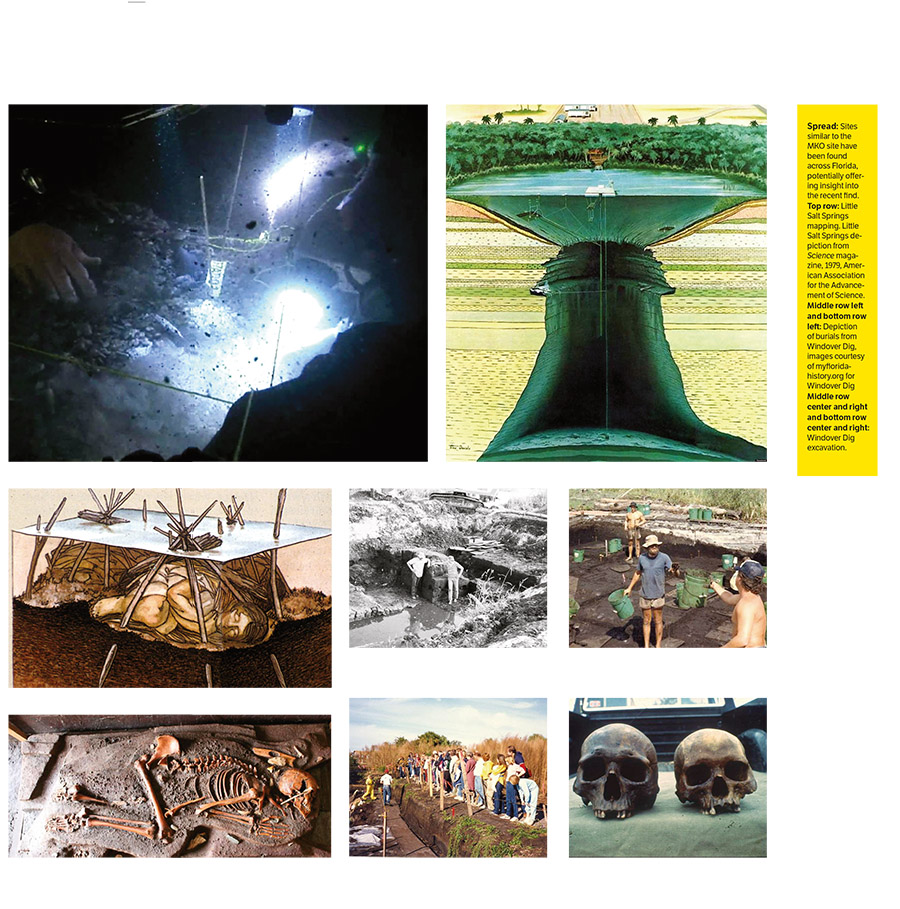
“That’s where we have an especially strong moral, ethical and legal responsibility as agents of the state,” says Duggins, “to be sure that these individuals are treated respectfully.” Today, Walsh-Haney pivots her research to preservation in order to help divers understand how to protect and preserve artifacts and remains in the environment. Using pigs submerged in an aqueous environment, she tests different combinations of sand and substrates to determine the safest and most reliable method.
But not everyone feels such moral, ethical or legal obligations, and a key threat to the preservation of the discovery at MKO remains the human element. Looters, treasure seekers, opportunistic tour guides—where scientists see opportunity for education, these people see a chance for a quick buck or an ancient souvenir, despite warnings from Venice Police, the Florida Fish and Wildlife Conservation Commission and the Florida State Department. Removing artifacts from the site constitutes a first-degree misdemeanor; disturbing a known burial site, a third-degree felony. Buoys mark the area and boats regularly patrol, night and day, but graverobbing and pillaging continue. “And some captains have been openly defiant,” says Mark Pritchett of the Gulf Coast Community Foundation, who has been working with the Florida State Department and local authorities as a sort of community liaison and local champion of the site.
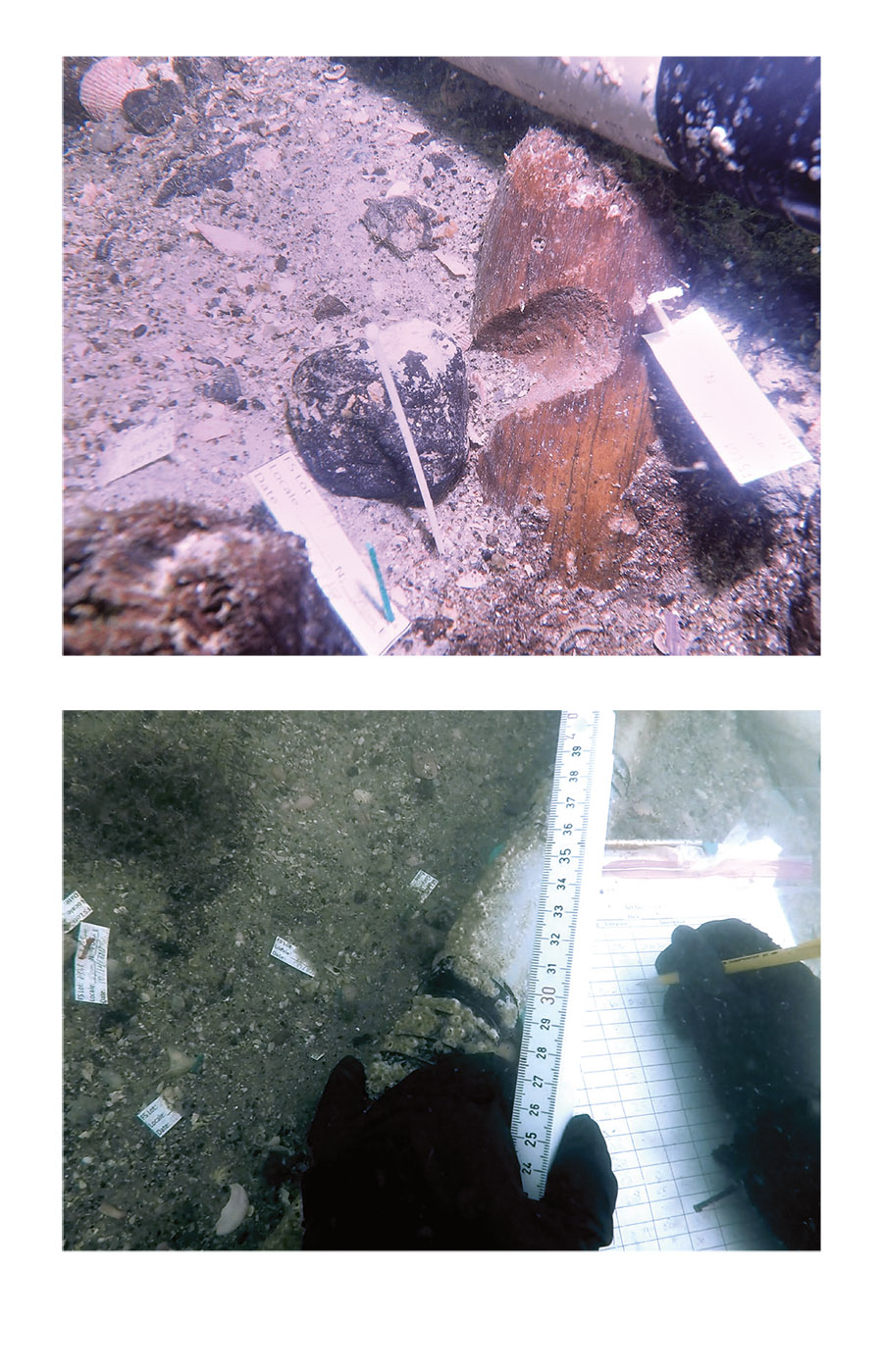
This page, top to bottom: One of the stakes excavated at Manasota Key Offshore revealed a notch in its length. It is not yet known what this was for, credit Ivor Mollema, Florida Department of State. Diver recording measurements at MKO, credit Bureau of Archaeological Research, Department of State.
Brought into the loop by the Florida Secretary of State, Ken Detzner, about two years ago, Pritchett and the GCCF have been something of the home team defenders of the site—“boots on the ground”—chosen in the belief that the best protection would be to rally the community itself. Since then, the GCCF has devoted resources to community education, helped install surveillance cameras and talked to those living around the site about the importance of staying vigilant and enlisting them in the preservation of what’s been found, through judicious use of an FWC hotline. The GCCF has even reached out to artists at Ringling College of Art and Design, hoping creative minds there could help the story capture imaginations and thus allegiance. “We need to make sure that people feel like they’re part of something bigger,” says Pritchett.
Big enough to rewrite the textbooks? “Definitely,” says Duggins. “When you’re able to have direct evidence of what the world was like that long ago, you’re able to have a little glimpse into how people behaved that long ago.” But it won’t last forever, and the sea will eventually reclaim its prize.
“We can do what we can,” says Koski, “but we should understand that this may be the only window of opportunity we have to investigate and understand what’s happening out there.”




